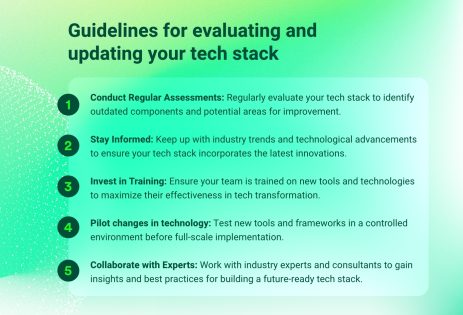As technology evolves rapidly, organizations must ensure their tech stack is future-ready to stay competitive, address current needs, and anticipate recent tech innovations. This blog post explores the key components of a next-ready tech stack and provides guidelines for evaluating and updating it.
Keeping up with rapid technological changes
The fast-paced nature of new tech advancements presents several challenges:
- Continuous Evolution: New tools, frameworks, and technologies emerge frequently, making it essential to stay updated.
- Integration Complexity: Integrating new technologies with existing systems can be complex and resource-intensive.
- Scalability Requirements: As businesses grow, their tech stack must scale efficiently to accommodate increased demand.
- Security Concerns: New technologies often bring new security vulnerabilities that must be addressed.
Identifying key components of a modern tech stack
To build a future-ready tech stack, consider integrating the following key components:
Cloud-native technologies
Cloud-native technologies provide the flexibility and scalability needed to adapt to changing demands. Utilizing services like AWS, Microsoft Azure, and Google Cloud can significantly enhance your tech stack’s capabilities. Cloud-native architectures facilitate seamless scaling, efficient resource management, and robust disaster recovery.
Microservices architecture
Microservices architecture allows for building scalable and maintainable applications by breaking monolithic applications into smaller, independent services. This approach enhances development agility, fault isolation, and scalability. Tools like Kubernetes and Docker are essential for managing microservices efficiently.
AI tech stack and machine learning integration
Integrating AI and machine learning into your tech stack can provide valuable insights, automate processes, and enhance decision-making. AI-driven tools like TensorFlow and PyTorch enable the development of intelligent applications that can adapt and learn from data.
DevOps and CI/CD pipelines
Implementing DevOps practices and continuous integration/continuous deployment (CI/CD) pipelines ensures faster and more reliable software delivery. Tools like Jenkins, GitLab CI, and CircleCI automate the testing, integration, and deployment processes, enhancing efficiency and reducing the risk of errors.
Enhanced security measures
Integrating advanced security measures into your tech stack is crucial as cyber threats become more sophisticated. Adopting a zero-trust security model and utilizing tools like Snyk for vulnerability scanning and Palo Alto Networks for threat detection can help protect your systems from potential breaches
Enhanced scalability and flexibility
Building a future-ready tech stack with these components ensures enhanced scalability and flexibility:
- Scalable AI Cloud Solutions: Cloud-native technologies allow seamless scaling to meet increasing demands.
- Adaptable Architectures: Microservices architecture enables rapid adaptation to changes and easy integration of new features.
- Intelligent Systems: AI and machine learning provide systems with the capability to learn and improve over time.
- Efficient Delivery: DevOps and CI/CD pipelines streamline the development process, ensuring timely and reliable software releases.
- Robust Security: Enhanced security measures protect against evolving threats, ensuring system integrity and data protection.

Building a full-stack technology is essential for staying competitive in the rapidly evolving technology landscape. Organizations can achieve scalability, flexibility, and efficiency by integrating key components such as cloud-native technologies, microservices architecture, AI and Machine Learning, DevOps practices, and enhanced security measures. Following the guidelines will help ensure your tech stack is prepared for the future.
At Globant, we combine AI-driven innovation with deep security expertise to help organizations stay ahead of cyber risks, from initial design to ongoing monitoring. Our Cybersecurity Studio and SSDLC approach ensure security is woven into every step of the development process, enabling faster, safer, and more resilient digital products.



